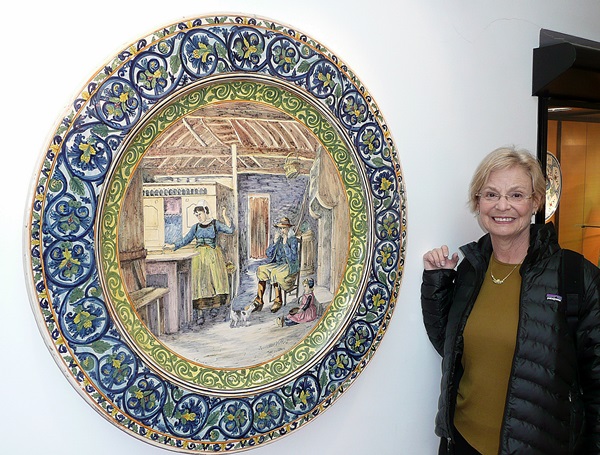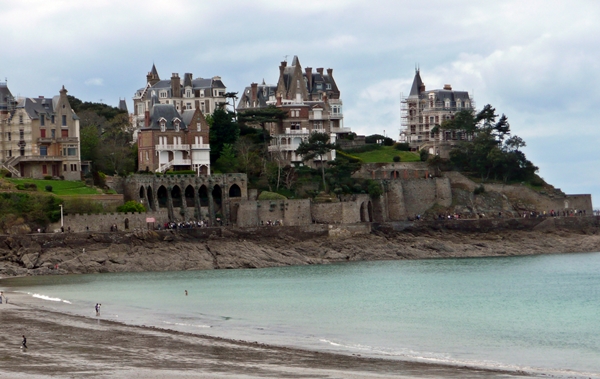Sunday, May 12, 2013
Max Jacob, Fine Art, and Flowers
This is our last touring day in France. Tomorrow we take the TGV train to CDG airport,
and Tuesday we fly home.
Bretons have their own language, derived from Celtic, which
is on all of the road signs:
Supposedly, significant numbers of children study the Breton
language in school, a reversal of a trend to eliminate it from public
life.
We began today thinking we were going to go to the fabulous chateau
I mentioned yesterday, but discovered (fortunately before we left) that it
doesn’t open for the season until June 1.
So we began our day visiting one of the few things open on Sunday
morning, the Fine Arts Museum, where we finally learned a considerable amount
about Max Jacob, a man whose name is honored in many places here in Quimper
(including a bridge—you can see the sign at the bottom of the above photo). According to Wikipedia:
After spending his childhood in Quimper, Brittany, France, he enrolled in the Paris Colonial School,
which he left in 1897 for an artistic career. He was one of the first friends Pablo Picasso made in Paris. They met in the summer of 1901,
and it was Jacob who helped the young artist learn French.[1] Later, on the Boulevard Voltaire, he shared a room
with Picasso,[2] who remained a lifelong friend (and was included in
his artwork Three Musicians).
Jacob introduced him to Guillaume Apollinaire, who
in turn introduced Picasso to Georges Braque. He would become close friends with Jean Cocteau, Jean Hugo, Christopher Wood and
Amedeo Modigliani, who
painted his portrait in 1916. He also befriended and encouraged the artist
Romanin, otherwise known as French politician and future Resistance leader Jean Moulin. Moulin's famous nom de guerre Max is
presumed to be selected in honor of Jacob.
Jacob, who had Jewish origins, claimed to have had a
vision of Christ in 1909, and converted to Catholicism.
Max Jacob is regarded as an important link between the symbolists and the surrealists, as can be seen in his prose poems Le cornet à
dés (The Dice Box, 1917 - the 1948 Gallimard edition was illustrated by Jean Hugo) and in his paintings, exhibitions of which were
held in New York City in 1930 and 1938.
His writings include the novel Saint Matorel
(1911), the verses Le laboratoire central (1921), and Le défense de
Tartuffe (1919), which expounds his philosophical and religious attitudes.
What this bio does not say is that despite his conversion
to Christianity, to the Nazis he was a Jew and he died of pneumonia in a
concentration camp waiting to be sent to Auschwitz (where he surely would have
died). The museum has an extensive
exhibit about him, his paintings, paintings of him by very famous artists, and
other material. Here are two settings of
his writing to music by Francis Poulenc:
After lunch we went to a garden recommended by our hosts
at the B&B. The Parc de Boutiguery
is a 20 hectare (50 acre) garden which is open only a few days a year, on the
weekends in spring. Just about all the
flowers are rhododendrons and azaleas, with a few other flowering trees and
bushes. We met the man whose work it is,
one Chritian de la Sablière, who is an amateur, not a trained botanist, but has
created literally hundreds of rhododendron and azalea hybrids. His friend, who is the president of the
French Rhododendron Society (I never knew there was such a thing) translated as
we spoke and learned about him and the garden.
It is truly enormous, a labor of love, and clearly not designed by a
professional garden designer, as there is a jumble of everything
everywhere. But it is astonishing:
And here the largest Azalea:
Well, unless there’s some adventure on the way home to
write about, that’s the end of the last post of the blog. I’m looking forward to the TGV train, and our
flight to JFK is on an Airbus A-380, the giant double-decker plane. This plane, believe it or not, is certified
to carry 853 people in the tightest all-coach configuration. Air France configures it to hold “only” 538. We’ll see how they manage that on the ground
and in the air. Thanks to all who sent
notes!
Victor














































